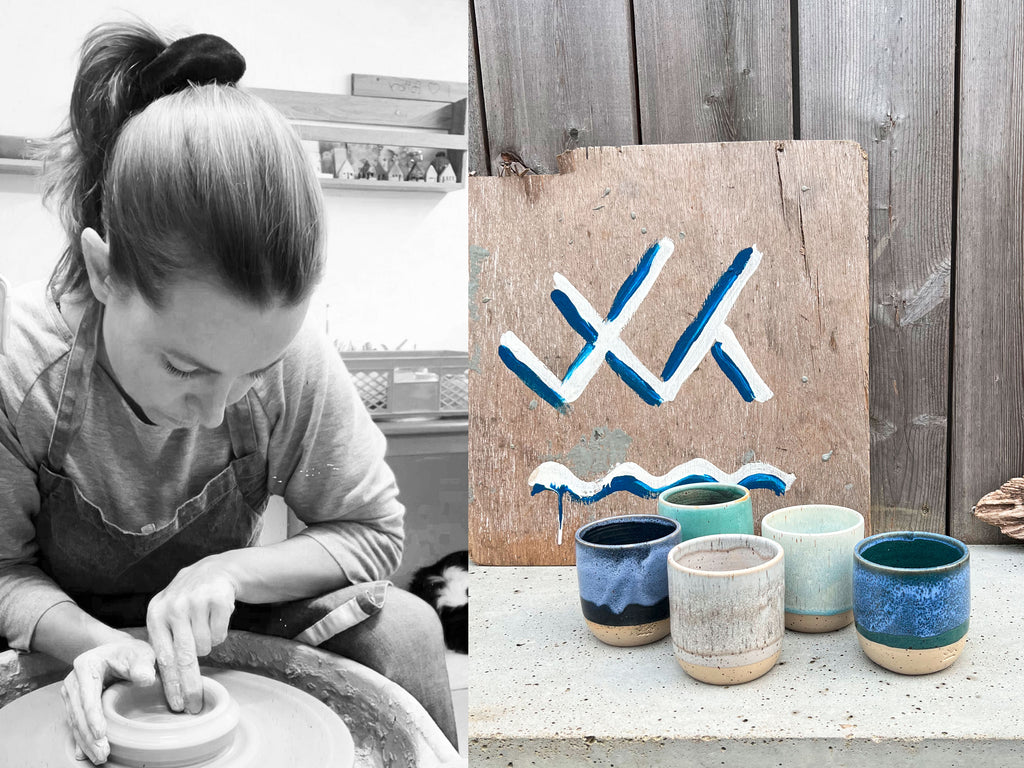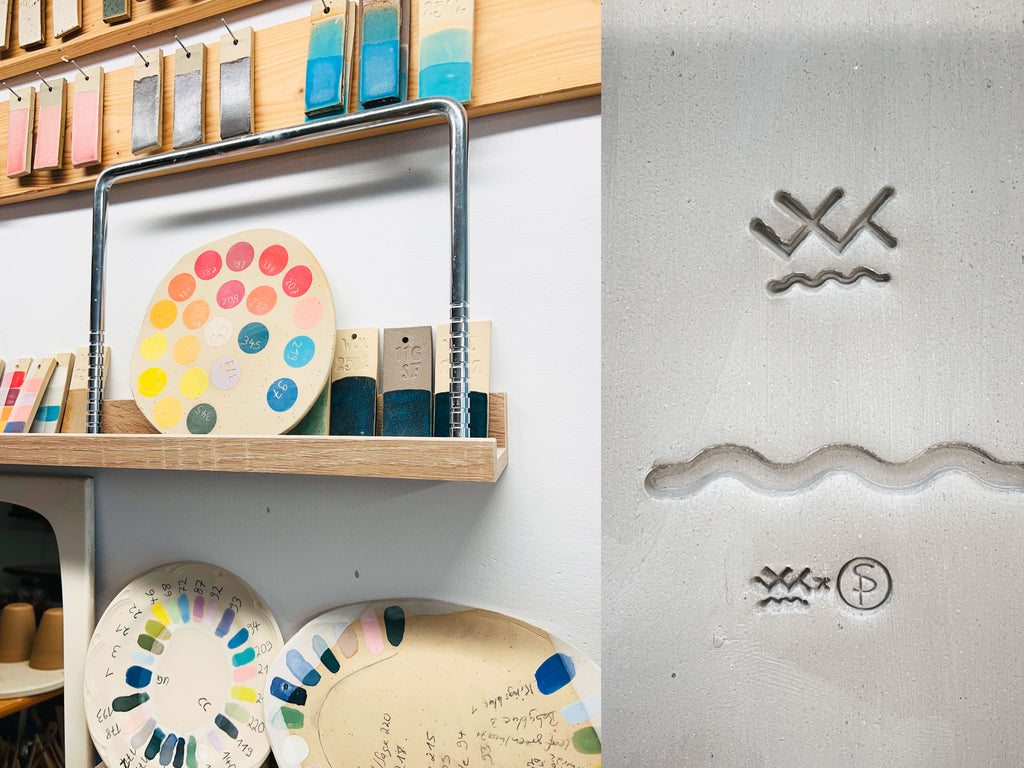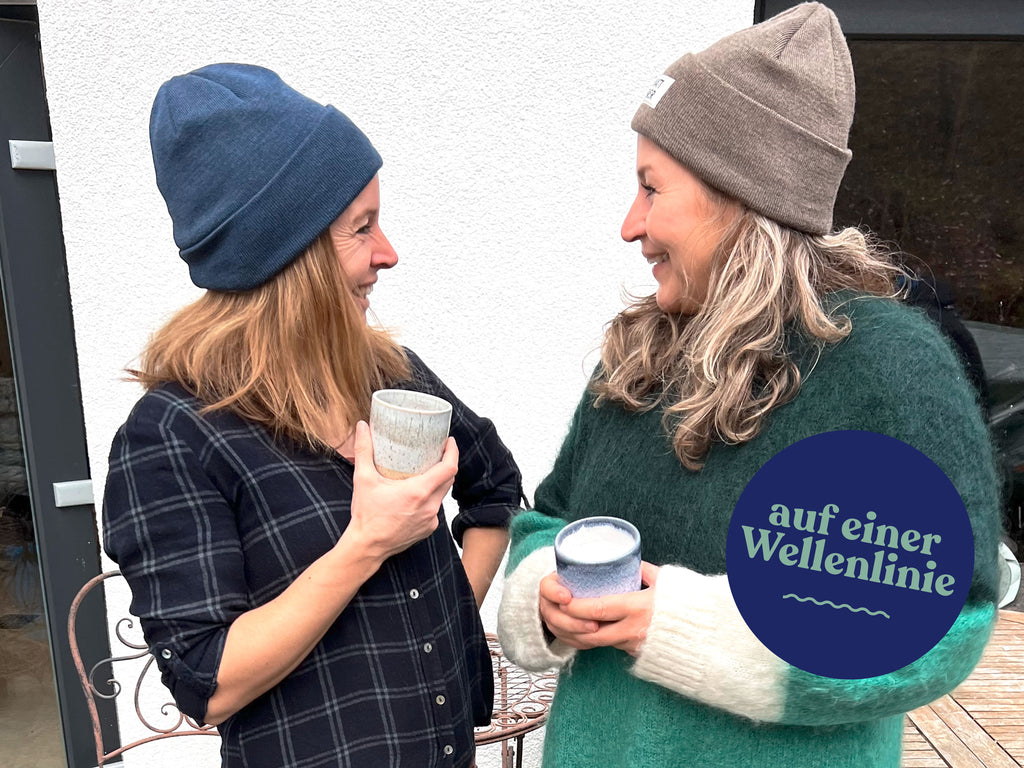Ocean Cups - discover our new unique handmade ceramic mugs

Between art and hand-turned ceramics - handmade fair in Germany by Sarah Porsch in a collaboration with Waterkoog and a lot of love for the details.
Katja, our Creative Director, came across Sarah's beautiful things on Instagram and immediately fell in love with the beautiful ceramics. As luck would have it, she was an acquaintance of friends, so the idea of making mugs that look like the sea from above began its journey.
We were immediately taken with the minimalism of the design and the great shapes. Since then, the mugs have accompanied us at breakfast, in the afternoon and at special moments in the house by the sea. We are so happy to show you the outcome of our joint cooperation!
The resulting mugs are something very special: they are pleasantly heavy in the hand, have a great feel and a great drinking rim. We are very enthusiastic about the look, because all the cups show Nordic moments by the sea.
Like a drone shot from above, the surf washes around the beach on the mugs. So we can dream ourselves even better to our favourite place at any time with a cup of tea or coffee. Mmmmmmhhh.
Our true favourite mug!
Each piece is unique. Just like you and me. All natural and 100% handmade with love. For real hygge moments. We're going crazy!
The beautiful sea mugs from the WK x SP ceramics co-op - a very special gift.
Perhaps also to yourself?
-----------------


Read in our interview with Sarah how she works and why pottery just makes her life better.
WK: How did you get into pottery?
Sarah: Creativity has always been in me. I am a teacher, studied art and tried out many creative techniques. I only got into ceramics much later, when I discovered an ancient kiln in the far corner of my small village school. Actually, I "only" wanted to give the children a great experience with clay.
How could I have known then that this was the beginning of a very great creative love and passion? In the beginning, I did a lot of modelling, but after some trial and error, I knew very quickly that I wanted to make functional stoneware ceramics. I am a self-taught artist and have spent hundreds of hours working on my skills on my own. I looked over the shoulders of artists virtually, watched, copied, failed, started again and learned and learned. Even today, I am still learning something new every day.
We love your ceramics - what is the process of creation like? How many steps are involved?
A lot of work goes into my handmade ceramics. For the mugs in our collection, there are a total of 12 individual steps. The clay is prepared and kneaded, then weighed. Then, through my hands, the clay takes shape on the wheel. When the clay is leather-hard, each piece is turned on the wheel to get its final shape. Once the logos are stamped, the cup is allowed to dry in my workshop. This takes several days. The first firing in my kiln goes slowly to a temperature of up to 950 degrees. This can take up to 18 hours. After cooling, the cups are washed and cleaned. The subsequent waxing ensures that the bottom remains free when dipped in the glaze. Otherwise it would melt into the kiln plate during firing. After the glaze has dried well, all the pieces are allowed into the kiln. The second firing follows - the glaze firing. Firing at approx. 1230 degrees makes the pottery stoneware: hard, food-safe, durable, ovenproof, microwaveable and dishwasher-safe (hand washing is still preferred, of course). It takes up to 40 hours before I can open the kiln with the ceramic again after a glaze firing in my workshop. After the final sanding of the base, the mugs then go on their journey north.
What is the most creative/exciting part for you?
The most beautiful part for me is turning the clay on the wheel. It's nice to feel the clay between my hands and give it the shape I have intended for it.



What do you love most about it?
When I'm spinning on the disc, I'm out of the world. For me it's like meditating. I switch off, come to rest, it grounds me. And the fact that I can make a beautiful cup with my hands from a natural product from the Westerwald fascinates me and always makes me proud. In my workshop I feel great happiness and deep satisfaction. I make something from what the earth gives, paired with the other elements of fire, water and air. It doesn't get any more beautiful than this.
The cups fit so fantastically well in the hand, how do you find the perfect shape?
The shape is very significant for me. The most important thing for me is that appearance and functionality come together perfectly. That's what makes a good mug in my eyes. I think the roundness of the cup fits the hand well on the one hand, but on the other hand it is heavy and robust. In my eyes, that expresses strength. A cup that can withstand storms and waves, that gives warmth and makes you want to go to sea.
What is the difference between hand-turned and industrially produced ceramics?
Hand-turned ceramics are a love of detail, not a mass product. In my workshop, I do every single step myself. My mugs are made as unique pieces with a lot of joy and attention to detail. Imported and industrially manufactured mass products can be found in abundance and far too cheaply in various shops. For me, ceramics is craftsmanship. This art gives the products a "soul", which is impossible with industrial ceramics.
You are also a lover of the North, which is something we have in common. How did you "come to it" and are there connections to ceramics?
My love for the Scandinavian countries and the sea inspires me a lot in my work. The Nordic style, this timeless-classic, this naturalness and the clear forms have always been what I like best. I grew up with classic Scandinavian style. Then, fittingly, I chose a northern man whose love of Denmark was the starting point for many wonderful trips to Scandinavia. In the past with a caravan, today with a van. The colours of the forests and the beaches, the sky and the seas fascinate and inspire me anew every time.
You developed the WK collection together with Katja, our creative director. How was the collaboration?
For me, working with Katja is a wonderful enrichment. Katja discovered me on Instagram and right from our first phone call I sensed that something very special could come of it. I like her enthusiasm for our project, I felt that immediately. I was fascinated by her manner, this determined lightness. We talked a lot about the sea, the beach and holidays in the north and looked for ways in which the cup could express our attitude to life. Her zest for life, her desire for ceramics and the desire for our cooperation are totally contagious. We both noticed immediately that we were on the same wavelength....


Handicraft has its price. The price level is of course different from the mug from the big Scandinavian furniture store... what does that mean for the mugs?
My ceramics are sustainable. I make products that people consciously choose and buy. They are unique, not one-off or ten-time items. This way feels good. I make favourite products for myself and others, mugs for special and conscious moments. Ceramics is tradition, is craftsmanship. Ceramics is original. From my point of view, people have had enough of mass-produced goods. They want something that not everyone has. That's very easy with handmade ceramics: every piece is unique.
Do you have any tips for people who would like to get started themselves?
Try it out! There are now courses again in many places. Just sign up for a workshop with a friend and let yourself be fascinated...
And finally: what is your favourite thing to drink from your mug?
That's easy: I love my latte. We only have my mugs in my family now, so we drink all our drinks out of them. Always feels good. I could imagine that for grog as well. I haven't tried it yet, but I'd love to drink it with you when I visit Hamburg. I'm sure it feels good too.
Thank you very much for the interview, dear Sarah!


Leave a comment